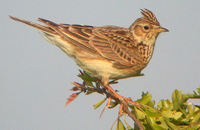Skylark
The sun rode high, the sky was clear,
The lark poured forth his strain,
And flowers, the firstlings of the year,
Shed fragrance o'er the plain.
There is nothing which signifies or expresses summer more, I think, than the skylark singing as it soars high against the sun in a clear blue sky. Such an ecstatic song for such a small plain bird. An exaltation of larks indeed!
 The skylark's most striking feature, and the one that gives the birds its name, is its song in flight. The territorial song of the male, heard mainly between August and January is an ecstatic torrent of variable trills and runs, sustained for up to five minutes while the bird soars high into the sky. It hovers 30-100 meters above the ground, facing into the breeze, and then drops slowly earthwards. The song ceases just before the final descent.
The skylark's most striking feature, and the one that gives the birds its name, is its song in flight. The territorial song of the male, heard mainly between August and January is an ecstatic torrent of variable trills and runs, sustained for up to five minutes while the bird soars high into the sky. It hovers 30-100 meters above the ground, facing into the breeze, and then drops slowly earthwards. The song ceases just before the final descent.
Lo, here the gentle lark, weary of rest,
From his moist cabinet mounts up on high,
And watches this morning, from whose silver breast
The sun ariseth in his majesty.
- William Shakespeare
Skylarks are ground-nesting birds and will breed from April to early August. Spring temperatures trigger the start of the breeding season. Choice of nesting site is influenced by the height and density of the crop. Ideal vegetation height is 20-50 cm. Skylarks generally hold the same territory throughout the season, and stop breeding activity when the vegetation becomes unsuitable for nesting. Highest densities are found in set-aside and spring-sown cereals, lowest in autumn-sown cereals and pasture.
Skylarks advertise their territories by a spectacular song-flight, during which the bird rises almost vertically with rapid wing-beats, hovering for several minutes and then parachuting down. Song flights of up to one hour have been recorded, and the birds can reach 1,000 feet before descending.
The nest is a hollow on the ground, lined by the female with leaves, grasses and hair. She lays 2-6 grey-white, thickly spotted eggs, and incubates them for 11 days. Both parents feed the chicks on insects for their first week, then gradually introduce small quantities of shoots and seeds for a mixed diet. Although the chicks leave the nest when only about eight days old, they fledge at 18-20 days of age, and are fully independent at 25 days. The whole cycle lasts 37 days.
Skylarks raise up to four broods in a season if suitable habitat is available. They must have at least two or three successful broods to maintain the population. The vast majority of cereal crops are now sown in the autumn, and these grow tall so early in the year that the birds are often able to raise only one brood. Birds in spring-sown cereals nest at twice the density and raise around three times as many chicks as birds nesting in autumn-sown crops. The area of winter cereal has increased at the expense of spring cereal, and the resultant reduction in reproductive output is believed to be the main reason for the population declines. Skylarks also commonly nested in grass grown for winter stock feed, but the switch from hay to silage means that the grass is cut too frequently to allow birds to breed successfully.
http://www.southendrspb.co.uk/skylark.htm